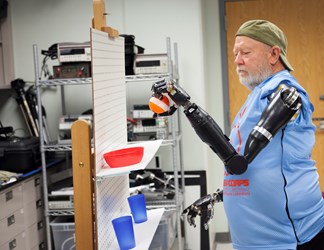Double Amputee Is First To Control Two Robotic Arms Simultaneously
By Chuck Seegert, Ph.D.

History was made recently when a bilateral, shoulder-level amputee learned to operate a pair of robotic prostheses. The patient performed complex tasks using both artificial limbs simultaneously. The modular prosthetic limbs (MPLs) are a product of Johns Hopkins University’s Applied Physics Laboratory, and the patient became quite proficient with just a small amount of training.
The control of robotic prostheses has been rapidly advancing, and these powered replacement limbs are becoming closer to a clinical reality. Some research efforts have focused on using brain wave recognition to drive the function of the prosthesis. Other approaches have used nerves that remain in the area of the stump to provide signals that the device detects and responds to.
Recently, a Johns Hopkins research team made advances in robotic prosthesis control that represents a great leap forward, according to a recent press release. Using a pair of MPLs, a Colorado man learned to perform several complex functions that would normally be encountered in real life. Perhaps more importantly, he only had to think about the movement, and his thoughts were translated into action.
The patient’s name is Les Baugh, and he lost his arms 40 years ago in an electrical accident. To get to the point where he could perform these activities, however, Baugh had to undergo surgery, according to the press release.
“It’s a relatively new surgical procedure that reassigns nerves that once controlled the arm and the hand,” explained Johns Hopkins trauma surgeon Albert Chi, M.D., in the press release. “By reassigning existing nerves, we can make it possible for people who have had upper-arm amputations to control their prosthetic devices by merely thinking about the action they want to perform.”
Once Baugh had recovered from surgery, he was fitted for custom sockets that fit his torso and shoulders, according to the press release. The device provided attachment points for the MPLs, and also provided an interface with the reassigned nerves. To practice controlling his limbs, Baugh used a system called the Virtual Integration Environment (VIE), which is a virtual reality test setting.
The practice was quite effective and, when fitted with his actual limbs, the patient was able to rapidly gain control of them and move several objects. For example, Baugh was able to take an empty cup from a counter at shelf height and transfer it to a higher position, which required eight separate motions. The significance of this accomplishment was that it was an activity that Baugh may encounter in the home environment.
Even more exciting was that the control demonstrated in the experiments was achieved after only 10 days of training, which implies that the system is very intuitive, according to the press release. In order to see how Baugh does with long-term training, the team decided to send him home with a pair of the MPLs to use in his daily life. After extensive practice in a real-world setting, the true potential of the system may be demonstrated even further.
Recently, other prostheses have incorporated forms of sensory feedback to help wearers become more aware of their environments.
Image Credit: Johns Hopkins University Applied Physics Laboratory
